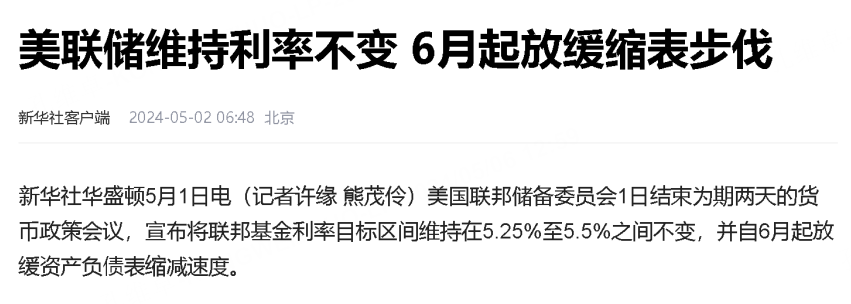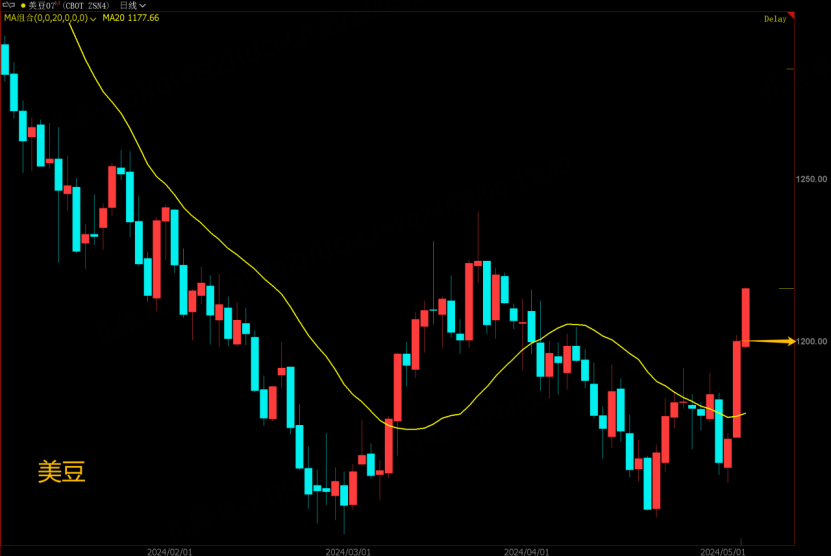Is It Time To Invest In Agricultural Commodity Futures' Markets
During the domestic May Day holiday, the practice of high volatility in the external market continues, but this time it is fulfilled in agricultural products.
Let me talk about the macroeconomic situation first. Although the Fed's interest rate meeting will not adjust interest rates as scheduled, the slowdown in QT (shrinking balance sheet) is a real liquidity easing measure. It is very likely that we may not see the Fed cut interest rates this year, but shrinking balance sheet The process is likely to end this year, so it is not an exaggeration to think that the Fed is now at an inflection point for re-easing.
The unexpected upset of the non-farm data provided a reason for the Fed to cut interest rates. When the unemployment rate is higher than 4%, it will be the time for the Fed to cut interest rates (currently 3.9%). According to my dollar cycle model, secondary inflation will get closer and closer.
Entering May, I will continue to track the situation of agricultural products with you in the post.
After all, the second half of the year is approaching, and many trading opportunities will be cashed out one after another. Everyone needs to keep an eye on the market. When the Federal Reserve slowed down QT, US soybeans were affected by the weather and began to enter the weather hype mode.
The US soybean weather speculation mode is usually divided into two types, one is that the flood during the harvest period hinders the harvest, and the other is that the drought during the planting period affects the yield. The current market belongs to the first type. During the harvest period in Brazil, the severe flood affected the harvest.
In terms of the degree of impact on the price, the first mode is not as good as the second drought mode, because the flood affects the harvest progress, unless the flood The soybean fields have been submerged for a long time, so that the output will be substantially reduced. If the time is not long, the impact on the output will not be too great. When the flood recedes, the harvest progress will make up for the price and the price will naturally be adjusted.
Therefore, the current U.S. soybean market can be understood as short-term speculation on the flood effect. Before the planting area report on June 30, it is estimated that the U.S. soybeans will be strong, but the range should not be too high. You can make a slightly long-term layout. If North America soybean planting encounters weather problems again, this is the main rising stage of the US soybean market. If the weather in North America is not strong, the price can only toss again.
In terms of strategy, U.S. soybeans and U.S. soybean meal can be bought in a small amount (must be a small amount), with 1200 points of the July contract as the stop loss.
If options are used, the risk control is better. 1200 points is the planting cost price of U.S. soybeans last year, so anchor this price to observe the market. If the soybean price falls below 1200 again, it means that the planting cost of U.S. soybeans will continue to drop in the coming year, and it is not suitable to hold it.
In addition, the weather pattern of U.S. soybean speculation is usually driven by soybean meal, while soybean oil does not fluctuate much or even falls. When the weather news eases and soybean meal no longer rises, you can transfer the meal futures position to soybean oil, which may better track Soybean market. Since Palestine and Israel may negotiate a ceasefire agreement in the short term, it is negative for crude oil, and the price of soybean oil follows that of crude oil. Therefore, when oil prices improve, let's look at soybean oil and don't rush to buy bottoms.
$NQ100 Index Main 2406 (NQmain) $$SP500 Index Main 2406 (ESmain) $$Dow Jones Main 2406 (YMmain) $$Gold Main Company 2406 (GCmain) $$WTI Crude Oil Main Company 2406 (CLmain) $
Disclaimer: Investing carries risk. This is not financial advice. The above content should not be regarded as an offer, recommendation, or solicitation on acquiring or disposing of any financial products, any associated discussions, comments, or posts by author or other users should not be considered as such either. It is solely for general information purpose only, which does not consider your own investment objectives, financial situations or needs. TTM assumes no responsibility or warranty for the accuracy and completeness of the information, investors should do their own research and may seek professional advice before investing.
- ATian·2024-05-07Great ariticle, would you like to share it?LikeReport
- zuzu99·2024-05-07Keep an eye on the market and make informed choices.LikeReport



